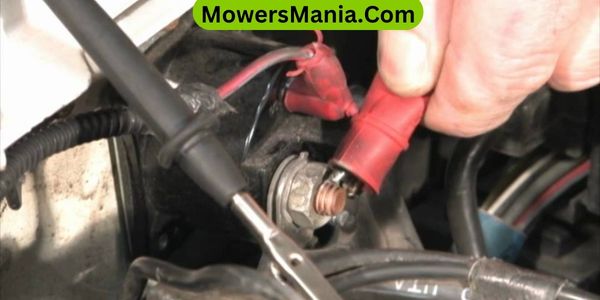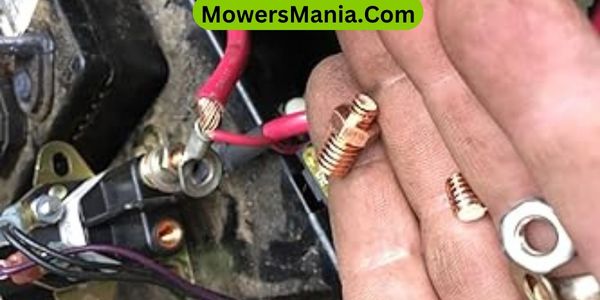Are you having trouble starting your lawn mower because of a faulty solenoid? Don’t worry, we’ve got you covered!
In this article, we’ll show you step-by-step how to jump the solenoid on your lawn mower to get it up and running again in no time.

With just a few tools and some troubleshooting tips, you’ll be able to fix this common issue yourself. Just remember to follow the safety precautions to keep yourself and your mower safe.
Let’s get started!
What Is a Solenoid on a Lawn Mower?
A solenoid on a lawn mower is a small electrical device that acts as a switch to control the flow of electricity between the battery and the starter motor.
It plays a crucial role in starting your lawn mower’s engine. When you turn the ignition key or push the start button, the solenoid receives an electrical signal from the battery.
It then uses this signal to engage the starter motor, which in turn rotates the engine’s crankshaft and starts the combustion process.
Think of the solenoid as a gatekeeper or a traffic cop for your lawn mower’s electrical system. It ensures that electricity flows smoothly and efficiently between the battery and the starter motor.
Without a functioning solenoid, your lawn mower won’t start, no matter how much you turn the ignition key or push the start button.
The solenoid is typically located near the battery or the starter motor, and it’s connected to both of these components using electrical wires.
It consists of a coil of wire and a movable plunger or armature. When the electrical signal is received, the coil generates a magnetic field, which then pulls the plunger or armature towards it.
This movement completes the circuit between the battery and the starter motor, allowing electricity to flow and starting the engine.
Tools and Materials Needed for Jumping the Solenoid
To jump the solenoid on your lawn mower, you will need a few tools and materials. These items are essential for successfully bypassing the solenoid and getting your mower running again.
Here is a list of the tools and materials you will need:
| Tools | Materials | Safety Equipment |
|---|---|---|
| Screwdriver | Jumper cables | Safety glasses |
| Wrench | Electrical tape | Gloves |
| Pliers | Wire cutters |
The screwdriver will be used to remove any screws or bolts that are securing the solenoid in place. A wrench may also be needed to loosen any connections.
The pliers will come in handy for gripping and manipulating wires. Jumper cables are essential for creating a temporary connection to jump-start the solenoid.
Electrical tape will be used to secure any loose wires or connections. Lastly, safety glasses and gloves are important to protect your eyes and hands during the process.
Having these tools and materials ready beforehand will make the process of jumping the solenoid on your lawn mower much easier and quicker. Remember to always prioritize safety and follow the manufacturer’s instructions.
Step-By-Step Guide to Jumping the Solenoid on Your Lawn Mower

To successfully jump the solenoid on your lawn mower, follow these step-by-step instructions.
- First, ensure that the mower is turned off and the engine is cool.
- Locate the solenoid, which is typically a small cylindrical device with two wires connected to it.
- Next, disconnect the negative cable from the battery to prevent any accidental starts.
- Take a jumper cable and connect one end to the positive terminal of the battery.
- Now, locate the small terminal on the solenoid, which is usually marked with an ‘S’ or a ‘+’ sign. Attach the other end of the jumper cable to this terminal.
- With the jumper cable in place, find a clean metal surface on the engine or chassis and connect the other end of the negative cable to it. This serves as the ground connection.
- Once all the connections are secure, carefully turn the ignition key to start the mower.
- If everything is done correctly, the solenoid should engage and crank the engine.
- Remember to remove the jumper cables and reconnect the negative battery cable once the mower is running.
Following these steps will help you successfully jump the solenoid on your lawn mower.
Common Issues and Troubleshooting Tips When Jumping the Solenoid
When jumping the solenoid on your lawn mower, you may encounter common issues and need troubleshooting tips. One common issue is a faulty solenoid. If the solenoid isn’t functioning properly, jumping it may not solve the problem. In such cases, you may need to replace the solenoid altogether.
Another issue you might face is a dead battery. If the battery is dead, jumping the solenoid won’t work as there won’t be enough power to start the mower. In this situation, you should consider charging or replacing the battery before attempting to jump the solenoid.
Additionally, a loose or corroded connection can cause problems when jumping the solenoid. Ensure that all connections are secure and free from corrosion.
If you still encounter issues after checking these common problems, it’s recommended to consult the manufacturer’s manual for further troubleshooting steps or seek professional assistance.
Remember to always prioritize safety and follow proper procedures when working on your lawn mower.
Safety Precautions to Keep in Mind When Jumping the Solenoid on Your Lawn Mower

Before jumping the solenoid on your lawn mower, it’s important to prioritize safety by following these precautions.
First and foremost, make sure the engine is turned off and the ignition key is removed to prevent any accidental starts. Additionally, disconnect the spark plug wire to eliminate the risk of the engine suddenly starting while you’re working on it.
Next, ensure that the area around the lawn mower is clear of any debris or obstacles that could cause you to trip or fall.
This includes removing any loose objects, such as rocks or branches, from the immediate vicinity. It’s also advisable to wear appropriate protective gear, such as gloves and safety goggles, to shield yourself from any possible injuries.
When jumping the solenoid, always use insulated pliers or a similar tool to avoid direct contact with the electrical components.
This will help prevent shocks or electrical burns. It’s also crucial to double-check that the battery cables are secure and free from any damage or corrosion before proceeding.
Lastly, it’s essential to follow the manufacturer’s instructions and guidelines when jumping the solenoid. Each lawn mower may have specific requirements and precautions that need to be followed for a safe and successful jump-start.
Frequently Asked Questions [FAQs]
Can I Use Any Type of Wire to Jump the Solenoid on My Lawn Mower?
Yes, you can use any type of wire to jump the solenoid on your lawn mower. Just make sure it is long enough and has a good connection to successfully bypass the solenoid.
How Long Should I Hold the Wire on the Solenoid to Jump It?
Hold the wire on the solenoid for a few seconds to jump it. Make sure the connection is secure and be cautious of any sparks. Consult your lawn mower manual for specific instructions.
Can Jumping the Solenoid Cause Any Damage to My Lawn Mower?
Jumping the solenoid on your lawn mower can potentially cause damage if not done correctly. It’s important to follow proper procedures and not hold the wire on the solenoid for too long to avoid any harm.
What Should I Do if Jumping the Solenoid Does Not Solve the Starting Issue?
If jumping the solenoid doesn’t fix the starting issue on your lawn mower, you should check the battery, spark plug, and fuel supply. If the problem persists, it may be best to consult a professional for further assistance.
Are There Any Risks Involved in Jumping the Solenoid That I Should Be Aware Of?
Jumping the solenoid on your lawn mower can pose some risks. It may cause electrical damage or even result in injury if not done correctly. It’s important to proceed with caution and consider seeking professional help.
Conclusion
Jumping the solenoid on your lawn mower can be a simple solution to get it running again. By following the step-by-step guide and keeping safety precautions in mind, you can quickly troubleshoot and resolve common issues.
Remember to gather the necessary tools and materials before starting. With some basic knowledge and a little effort, you can easily jump the solenoid and get your lawn mower back in action.



